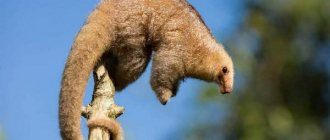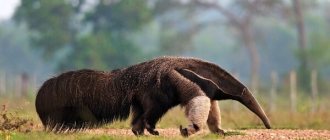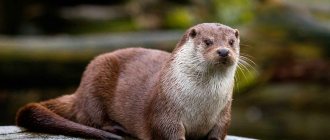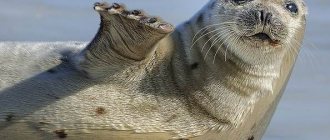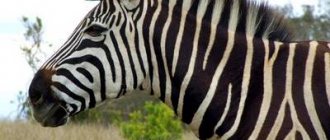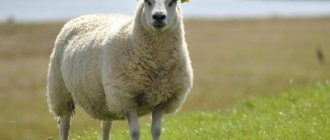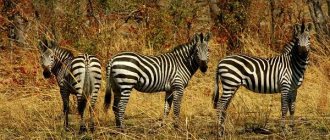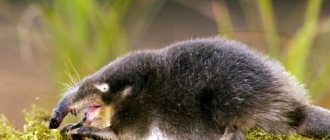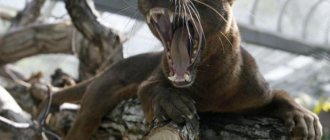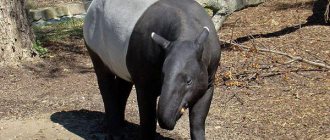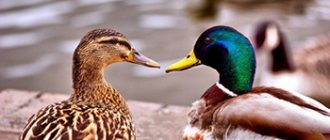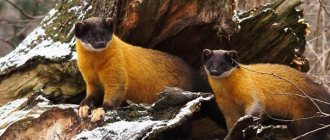Anatomical characteristics and features of the anteater
The anteater (lat. Myrmecophaga tridactyla) is from the order edentates. The appearance of the exotic animal is very bizarre. For a figurative comparison, let us remind you that from the same order are armadillos and sloths, the distinctive characteristics of which are a long tail, tongue and strong legs, thanks to which the animal easily moves through the trees.
The anteater is a fairly large mammal. The length of its body reaches up to 130 cm. Larger specimens are found - up to 2 meters, with almost half of it being its tail. The anteater weighs from 30 to 40 kg. But in the order there are also dwarf representatives, no more than 20 cm in length and weighing no more than 400 grams.
An interesting point is the structure of the head. It is very elongated, has two small eyes, and is 1/3 of the entire length of the body. If other animals have two developed strong jaws, then in the anteater they are practically fused and have no teeth. And why would they, given his lifestyle and diet, he doesn’t need teeth.
But the pride of the anteater is its long, powerful tongue, which reaches 0.6 m in length, this is the largest representative. This language makes it a copy of the Guinness Book of Records, since there are no other owners of this size in nature.
The anteater's tongue contains many tenacious fibers, thanks to which it becomes tenacious, and wetting it with copious saliva makes it sticky. There are a pair of small ears and a pair of eyes on the head. This is the “refined” face of the anteater.
The animal has two pairs of powerful paws, at the ends of which there are long and strong claws, reminiscent of the claws of sloths. The claws on the hind legs are slightly shorter than those on the front legs. Each claw is about 10 cm. The anteater has a very well developed sense of smell and hearing. Thanks to such abilities, he easily finds food for himself, as well as shelter from the enemy.
The anteater's tail is no less interesting. It was given to him to easily move through the trees. The length of the tail can be up to 90 cm. The color is brown with dark stripes. The coat is very hard, reminiscent of porcupine fur. The cover on the head is shorter than on the back. On the back the hairs are up to 25 cm long, and on the tail up to 40 cm.
What does it look like
The mammal looks like this:
- long narrow muzzle, like a tube;
- tiny narrow eyes;
- a long tail.
The animal weighs up to forty kilograms, its length reaches two and a half meters (from body to tail). Silver-gray fur, with a darker color on the back. From the black chest there are diagonal wedges, also dark in color.
The body length of this large animal is up to one hundred and thirty centimeters.
Lifestyle and habitat
The anteater is an American animal. It can be found in the latitudes of South America. The natural habitat is tropical rainforests with lush vegetation.
But some can do just fine without forests, living on the coasts and nearby savannahs. They prefer warm areas, so they do not like northern latitudes. Anteaters live in nature and lead different lifestyles:
- land animals that cannot climb trees, usually of gigantic size;
- arboreal, prefer to live only in trees, as a rule, they are dwarf;
- terrestrial-arboreal with four toes on their paws, leading a cooperative lifestyle.
Mammal activity begins in the evening. Prefers deserted places. Giants wander in search of food during the day, again in places where there are no people. They sleep most of the day, for about 16 hours.
Long claws prevent large individuals from walking, so they bend them inward and step on the outside of the leg. Shifting from foot to foot, they resemble a bear. Nails are only needed to destroy large anthills, as well as to fight off enemies. Some anteaters can swim, and over long distances, if there is no threat from crocodiles in the water.
The anteater even in the photo looks like a kind animal. In nature, it is very peaceful and does not cause fear, which is why it began to be tamed by people. What is it for? Just for the exotic. The animals get along well with other pets and play with children.
Keeping anteaters at home is a troublesome business. They cannot tolerate cold weather. Winter is an unknown phenomenon for the anteater. As you know, there is no winter as such in the tropics. The optimal temperature at which they feel comfortable is 24 degrees.
Keeping at home
Anteaters are not kept at home very often, which is due to the relatively high cost of exotic animals and the need to provide them with the most comfortable conditions for their stay. The tropical animal requires strict adherence to the temperature regime in the room at 24-26°C.
Personality of the domestic anteater
Domestic anteaters get along well with any other pets and get along well with children.
Among other things, the long claws on the forelimbs require periodic sharpening, so anteaters often render furniture and interior items in the room unusable.
Diet of the domestic anteater
Domesticated animals need to be provided with high-quality nutrition that can fully replace natural food. Minced meat, well-cooked rice, chicken or quail eggs, and fruits can be a worthy replacement for insects.
Where to buy an anteater
In recent years, anteaters have become quite competitive with many domesticated wild animals, including snakes, ferrets, foxes, raccoons and iguanas. You need to purchase exotics from a specialized nursery, where the health of the pets is monitored. The average price of a young domestic anteater is $5-6 thousand. Animals raised in captivity produce offspring only in the first generation, and then the resulting young are kind of sterile, therefore unable to bear offspring.
https://youtube.com/watch?v=fzURf5fvDw4%3F
By submitting a comment, you confirm that you agree to the processing of personal data in accordance with the privacy policy
Kinds
The population of anteaters is not very large. Only a few species are found in nature.
Giant anteater . Giants are almost always on the ground and are not adapted for climbing trees. These are the largest representatives of this order of animals. They can reach more than 1.5 meters in length, but this does not take into account the size of the tail. If measured completely, the length from the nose to the end of the tail will be about 3 meters.
Giants prefer to hunt for insects at night. The activity period is up to 8 hours. The rest of the time, anteaters sleep. They sleep under trees, in thick grass, thereby hiding from enemies.
Pygmy anteater . This midget lives in the humid tropics of South America. Thanks to its small size, it climbs trees very well and very quickly. If giants are not agile, then dwarfs are very fast animals. They sleep exclusively in trees, hiding in dense foliage.
The length of the dwarf anteater is up to 40 cm, and its weight is about 400 grams. These mammals are brown in color with a golden tint. The skin on the soles of the limbs is red. The nose is less short than that of terrestrial specimens.
The mini anteater has a very prehensile tail, which serves as a means of transportation. They roll up perfectly into a ring, wrapping themselves around branches and tree trunks. Muscular and highly developed front legs with long claws are added to the tail. There are single specimens, since dwarf anteaters are solitary in life.
Tamandua ( four-toed anteater ). The tamandua, or otherwise the Mexican anteater, is a cross between a giant and a dwarf. Its dimensions:
- body length 55-90 cm;
- weight about 4.5-5 kg;
- tail length 90 cm.
A distinctive feature of the tamandua is its hearing acuity with rather poor vision. The mouth opening is very narrowed, it is sufficient for the tongue to penetrate. The tail is prehensile and long, without hair. The Mexican anteater has 4 claws on its front legs.
Among all the species, the tamandua is the stinking animal. It needs the smell to scare away enemies. The color of the Mexican is interesting. The general coat is light yellow in color, while the fur on the back and belly is darker in color.
Marsupial anteater or numbat. Another name for ant-eater. A not very large mammal, reaching a length of up to 40 cm including its tail. The nambat weighs about 0.5 kg. In such animals, the female is smaller than the male. This representative of the anteaters looks a little different. His eyes are large, his tongue is only 10 cm long.
The elongated head has two pointed ears. The tail is long and abundantly covered with hair, less tenacious and developed than that of other anteaters. The nambat has 5 toes on its front paws and 4 on its hind paws. The paws are widely spaced.
The habitat of this animal is Australia. A special feature of this animal is the presence of small teeth. Due to the fact that ants and termites are favorite delicacies, the animal is assigned to the order of anteaters.
The offspring are gestated for about 2 weeks. Babies are carried on the mother's belly, attached to the nipples. In total, there are from 2 to 4 cubs in a litter. The lifespan of these anteaters is up to 6 years.
Conservation in nature
Local residents rarely hunt anteaters for meat; Tamandua skins are used in artisanal tanning, but only insignificantly. However, the giant anteater has disappeared from much of its historical range in Central America due to habitat destruction and human activity. In South America, anteaters are often hunted for trophies by animal traders. In some parts of Peru and Brazil they were completely exterminated.
Tamandua is also persecuted - it defends itself effectively, so they hunt it for sport with dogs. Tamanduas often die under the wheels of cars. However, the most serious threat to these animals is habitat loss and the destruction of the few insect species on which they can feed.
Nutrition
The anteater lives in places where there is a lot of vegetation, and therefore insects. In natural living conditions, food for animals is ants and winged termites, and the smallest species of them, due to the lack of teeth. The animal swallows the ants whole. It can absorb up to 30 thousand insects per day. This is where the name of the animal comes from.
Having found the insects' home, it destroys it with the help of its front paws. When the insects run away, the sticky tongue is already overtaking them. The ants are eaten. I don’t mind eating the bee families that are located in the trees. But only climbing dwarf anteaters prefer such a delicacy.
If during the day the animal was unable to find an anthill, then soft larvae of various beetles found in old trees, in the ground, in grass can also serve as prey. While swallowing insects, the anteater tries to crush them against the sky. For better digestion, the anteater licks fine sand and pebbles, which will subsequently grind the food in the stomach.
The habitat of one anteater is quite modest. It is capable of roaming short distances, so they search for food in the vicinity of 1 km. If food is very scarce, then they expand their territories to 2-3 km.
You can see the picture: a wandering giant with his head constantly lowered, constantly sniffing something, sticking out and retracting his long tongue. Their long nose resembles a vacuum cleaner that sucks in something. The animal is very strong, so on its way it turns over old driftwood, trying to find another termite mound.
During the night meal, the anteater's tongue is in constant motion. He is capable of performing 160 motor movements in a minute, licking food on his way. The anteater has very developed salivary glands, so the surface of the tongue is constantly moistened with them.
PERFECTLY SET FOR YOUR FAVORITE FOOD
The giant anteater's menu includes larvae, worms and soft fruits. But most of all it eats ants and termites, which it searches for using its well-developed sense of smell. Having reached an anthill or termite building, it opens the colony with its front paws with sickle-shaped claws. Then he launches a long, sticky tongue into their passages. He retracts his tongue into his mouth up to 160 times per minute. The prey is scraped off against horny tubercles in the long, slightly curved mouth and sent to the stomach, where the food is processed. In a short time, he licks up several hundred ants and then goes on his journey. Thus, the ant colony is not completely destroyed and can soon visit them again.
To protect itself from bites, the giant anteater has very thick and hard hair. Additionally, by using his thick, fluffy tail as a broom, he can free himself from his little tormentors.
Reproduction and lifespan
Anteaters mate twice a year: in autumn and spring. The duration of pregnancy, depending on the type, ranges from 3 to 6 months. A newborn animal is completely hairless; it immediately climbs onto its mother’s back and continues its development there.
Not only females take part in raising their babies, but also dads occasionally carry them on their backs. It is very interesting that animals do not abandon their babies, but carry them until the next pregnancy. Little anteaters ride on their parents' backs for up to one month, after which they begin to take their first steps, but under the watchful gaze of their mother. Children live with their parents until they are two years old.
The female anteater the baby with her burps for the first month of her life; only from the age of one month do they begin to lick small ants on their own. Puberty occurs at the 2nd year of life. Typically, anteaters live alone, and only at the time of mating do they look for a second individual.
On average, giant anteaters live up to 15 years, and tamanduas, like dwarf anteaters, live up to 9 years. Undoubtedly, the duration of each individual depends on the presence of nearby enemies that can harm the mammal.
Members of ant colonies
The inhabitants of the anthill are divided into 4 groups:
- Females (queens) are the founders of any ant house; their function is to lay eggs. There is only one female queen in the colony, which the ants carefully protect, feed and nurture.
- Males. They die some time after mating (their main function).
- Worker ants (foragers). Their responsibilities include caring for all members of the family, delivering food and protecting the anthill from attacks by enemies.
- Larvae. Future offspring. Larvae are divided into 2 types: those capable of feeding on their own and those requiring feeding. The latter species predominates; adult ants feed such larvae with semi-digested food from their own esophagus.
This entire large family needs huge amounts of food. What do ants eat?
https://youtube.com/watch?v=6cqXS7akwBw
Some insect lovers keep harvester ants as pets. To create an ant farm, you need to purchase a special aquarium made of glass or transparent plastic (formicarium) and place filler inside. The main conditions are the creation of a comfortable temperature and humidity, sufficient lighting.
Formicarium with sand
Enemies of the anteater
Who can be called an enemy for an anteater? Large land animals can be harmed by jaguars and lions. But for dwarfs the circle of predators expands. They can expect danger not only from predatory cats, but also from huge birds (eagles) and poisonous snakes.
Interestingly, dwarf animals, sensing danger, stand on their hind legs, and put their front legs forward, in front of their muzzle, spreading their long, sharp claws wide. And tamandua also emits a scent. Giant land animals use their long claws to escape. One blow from a large anteater is enough to kill a dog.
solitary animal They are usually active at night and feed exclusively on small insects and their eggs. To compensate for vitamin deficiency, they can eat various fruits. Upon reaching 2 years of age, they undergo puberty and the mating season begins.
The female mates twice in a year. Parents carry their baby for up to two years, without leaving him for a minute. After the appearance of the second baby, the first begins an independent life, which on average lasts up to 15 years, depending on the type of animal.
Wild Lifestyle
The anteater animal is quite peaceful, the main thing is not to anger or threaten it. All day long, all he does is walk around in search of anthills and termite mounds to feast on insects. Other predators try to avoid this clumsy goosebump lover. He does not run away from danger, but turns to the enemy, stands on his hind legs and embraces him in a “deadly embrace,” launching his sharp, huge claws into his body. The anteater never attacks first.
Anteaters cannot be called homebodies, and they don’t even have a home. Throughout their lives, they wander, moving from place to place, and do not develop their own lair. They prefer to live in open and semi-open areas.
The large anteater is a terrestrial animal; climbing trees is not in its habits and capabilities. During the daytime, these predators like to sleep and relax in a secluded place, and at night they are active. The anteater cannot walk quickly, much less run - its claws interfere with it. In order to somehow move, the animal bends them over.
Conservation in nature
Local residents rarely hunt anteaters for meat; Tamandua skins are used in artisanal tanning, but only insignificantly. However, the giant anteater has disappeared from much of its historical range in Central America due to habitat destruction and human activity. In South America, anteaters are often hunted for trophies by animal traders. In some parts of Peru and Brazil they were completely exterminated.
Tamandua is also persecuted - it defends itself effectively, so they hunt it for sport with dogs. Tamanduas often die under the wheels of cars. However, the most serious threat to these animals is habitat loss and the destruction of the few insect species on which they can feed.
